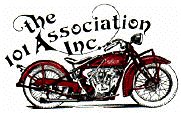Congrats to the purchase, Max! I'll tell what I would do with it: Check the condition of the oil and gas tank inside with a snail camera, clean up if needed. Then a regular service, grease the bike up everywhere, there is some 20-25 positions for oil and grease service.... Check oil pump function, plugs, valve and breaker gaps, chain, brakes, head stock and wheel bearing play... Then ride it like you stole it and have fun!
I might ditch the cocker tires for some more durable and roadworthy tires and see to that I had thicker off road tire tubes in it..19 inch wheels is good and in fact an option from factory with Chief wheels. You have great sources for high quality spare parts in Germany and nearby, even tacho repair shops, so that shouldn't be an issue. The 101 club is a great resource and the German Indian club is large and would help you out big time.
If the engine is not run for many years or you are uncertain of the condition. Preferably with an empty oil tank, check the function of the oil pump. Measure the distance between the adjusting screw head and stop nut (A and B), mark up and take pictures of the position, remove the screw and keep the stop nut in the same position on the screw as best as possible.
Probe in the screw hole with a hardened steel wire (a spoke is ok) and push on the swage plate inside to feel that it moves in and out a few millimetres and spring back. Rust in the oil pump forward compartment can sometimes accumulate and jam the pistons and swage plate. A teaspoon of oil or light grease in the hole is not bad, before remount the adjusting screw with it's stop nut to the same position.
If that is ok then with an empty oil tank or removed feed tube, remove the screw underneath (D) let someone kick the engine over and see to that the drum is turning, it is turning very slow, 19 turns of the crankshaft turns the drum one revolution. You can see 2 slots in the drum pass by in the hole if the drum is turning. Remount the screw plug preferably with some locktite. Original there is a thin lead washer that tighten from leakage, the seat in the pump body is concave for that reason.
Fill the gas tank only, leave it for a day and night and check for leaks anywhere, especially into the oil tank. Faster results can be accomplished with acetone that has lower surface tension.
Position of seeping small leaks can be spotted with sheets of single layer paper towel taped over areas, and wrapped to fittings and tubes. The towels can be applied also on test runs!
If that is ok then fill the oil tank and remove screw (C) and bleed the feed tube from air, that can take a short while. When clear oil without bubbles is oozing out remount the screw, original there is a fibre washer that seals. I also use locktite on that screw because a lost screw will ruin the engine.
Be careful to not overtighten the oil tube nut, the oil pump casting is brittle. If oil leakage occurs, the lining up, or position of the oil tube to the pump is very precise and the tube might need some fine tuned bending. Or it is something wrong with the conical sealing area on the line or in the body. The precision of the tube position is equally important under the tank. The tube is very stiff so bending the tube is best and safest done with both ends disconnected and off the bike.
The tube should be mounted without stressing any of the fittings. Basically when tightening either of the nuts individually, the tube should not move, tweak or twist at all. It takes lots and lots of bending and test fits to get it good. Exact same goes for the gas line, any stress may induce a fatigue breakage of the copper tube after a period of time.
Tighten the nut on the pump always before tightening up the tank fitting nut (if something breaks at the tank fitting, replacement parts are easier to find). The oil drop on the tube might indicate you have a small leak at the tank fitting.
Nick_Moss@ripmax.com is selling test plugs, and advice on how to tune up the oil pump delivery can be found in other topics on this forum.


